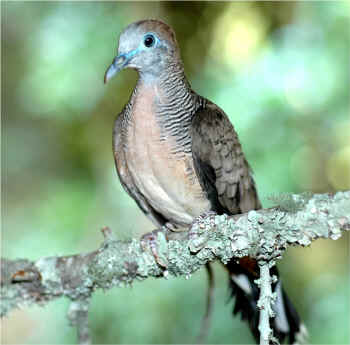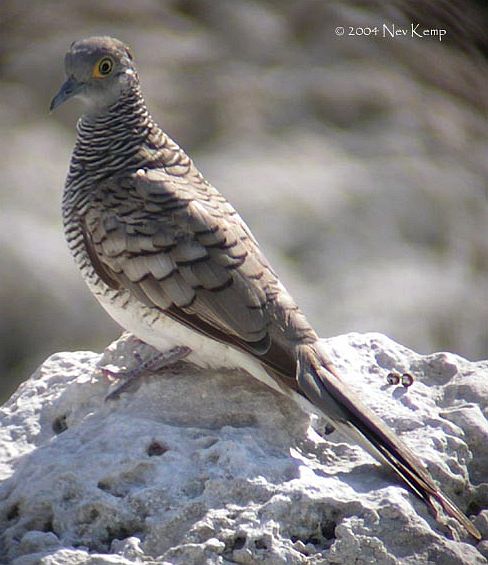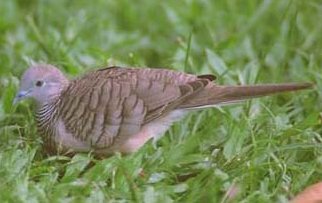MAIN MENU
Diamond Doves
Site Map
Diamond doves
Acquiring Diamond Doves
Caring for Diamonds
Living With Diamonds
Raising Diamonds
Growth of a Diamond Baby
One Year's Reproduction Data
Tribute to China
Other Dove Species
Other Geopelia Species... Diamond Dove
... Zebra Dove
... Barred Dove
... Peaceful Dove
... Bar Shouldered Dove
Ringneck doves
Eurasian Collared Doves
Cape doves
Mourning doves
Mourning Dove Baby Growth
Rock doves
North American Doves
Dove Genera of the World
All Doves
Caring for Injured or Sick DovesTaming Doves
Other
Books of Interest
Some Bird stories
About Me
Links
Informational Sites
American Dove AssociationCommercial Sites
Jeff Dowining - Diamond DovesGarrie Landry - Diamond Doves
Wade Oliver - The Dove Page
Doveland Press - Diamond Doves
The Geopelia Doves

Zebra Dove
A page on the genus Geopelia is included here because it was felt that those who keep diamond doves would be interested in the characteristics of the other species in the genus. The five doves in this genus are all similar in that they are small or very small, with long tails, and have either barred or spotted plumage. The five species can be divided into three groups according to their physical appearance.
First there is the diamond dove which has a spotted plumage while the other four species have barred plumage. Then the bar shouldered dove is considerably larger than the other four species having a weight in excess of 110 grams while the other four species have a weight between 20 and 70 grams. The three remaining species, the zebra dove, the barred dove, and the peaceful dove are very similar. The barred dove is distinct from the Peaceful Dove and the Zebra Dove in that it has yellow colored skin around the eyes. The Peaceful Dove and the Zebra Dove both have blue skin around the eyes. It should be noted that in 1992 R.E Johnstone included all three of these doves as races of a widespread species. Gibbs followed White and Bruce's narrower species definition in their 1986 book.
It is probably worthwhile to understand how the scientific names of the Geopelias have evolved as the old and new scientific and common names can be found throughout the literature especially when searching the internet. On many Australian internet sites, the peaceful dove is still given the scientific name G. striata and the common name "barred dove" any be applied to G. placida, G. striata, as well as G. maugei.
In his 1967 edition of Pigeons and Doves of the World, Derek Goodwin included all of these species as sub species of the zebra dove (G striata):
- G. striata striata - located in the Indo Malayan regions
- G. striata placida, G. striata tranquilla G. striata clelandi - located in Australia
- G. striata maugeus - located in the Lesser Sunda Islands
Goodwin stated that the Australian forms are paler than the Indo Malayan forms and this seems to be born out by the photos included here. But he did indicate that these forms had barring across the front and sides of the breast. He did not distinguish between the differences of the three Australian forms. He said the Lesser Sunda Islands form is darker than the others and the entire breast is strongly barred.
The bar shouldered dove was not included in the 1969 edition of Pigeons and Doves of the World but did appear in the 1983 edition.
In the 2001, in the Gibbs, Barnes, and Cox book, Pigeons and Doves, A Guide to the Pigeons and Doves of the World, the authors describe the following five species:
- G. cuneata - Australia
- G. striata - Malaya, Indonesia
- G. maugei - Lesser Sunda Islands
- G. placida - Australia
- G. humeralis - Australia
G. striata tranquilla and G. striata clelandi were named as subspecies under G. placida along with a new subspecies G. placida papua.
- G. placida placida - Northern Australia
- G. placida papua - New Guinea
- G. placida tranquilla - Southern Australia
- G. placida clelandi - Western Australia
The following three subspecies have been named under G. humeralis:
- G. humeralis humeralis - Eastern Australia
- G. humeralis gregalis - New Guinea
- G. humeralis headlandi -Western Australia
Distinguishing characteristics for each subspecies are so slight that no attempt will be made to list them here. In the Gibbs, Barnes, and Cox book they are described as geographic variations.
All of these species inhabit the relative open and dry savannahs and other semi arid regions. The zebra dove and the peaceful dove often inhabit urban areas and other man altered areas. The larger bar shouldered dove prefers wetter habitats than the other four species.
Photo credits are at the bottom of the page. Permission to use any of the photographs here must be obtained from the photographer.
| Name | Range | Length & Weight | Photograph |
| Diamond Dove Geopelia cuneata
|
Central , west and north Australia | 194 - 213 mm male
(2)
193 - 205 mm female 23 - 45 grams |
|
| Zebra Dove Geopelia striata
|
SE Asia to Java, Bali, and Lombok. Also in the Philippines, Sulawesi, Borneo, St. Helena, Seychelles, Hawaii, and Tahiti | 205 - 215 mm male
(2)
206 - 209 mm female 50 - 62 grams |
 |
| Barred Dove Geopelia maugei
|
Lesser Sundas | 232 - 258 mm male
(2)
210 - 233 mm female 81 grams estimated |
 |
| Peaceful Dove Geopelia placida
Subspecies |
Australia except SW, S New Guinea | 208 -
214 mm male (2)
179 - 191 mm female 40 - 60 grams |
 |
| Bar Shouldered Dove Geopelia humeralis Subspecies |
Australia and New Guinea | 293 - 305 mm male
(2)
280 - 301 mm female 110 - 160 grams |
 |
Photo Credits
G. striata - Helen White
G. cuneata - Helen White
G. striata - Helen White
G. maugei - Neville Kemp, UK/Indonesia
G. placida - Philip Hamilton, Australia
G. humeralis - David Armbrust, Australia -
http://www.anhs.com.au
References
(1) Brown, Danny, "Diamond Dove, Geopelia cuneata", "Peaceful Dove, Geopelia placida", "Bar-Shouldered Dove, Geopelia humeralis", A Guide to Pigeons, Doves & Quail, Their Management, Care & Breeding, South Tweeds Heads, Australia: Australian Birdkeeper 1995, pp. 114-122(2) Gibbs, David; Barnes, Eustace; Cox, John "Geopelia", Pigeons and Doves, A Guide to Pigeons and Doves of the World, London: Yale University Press 2001, pp. 311-317
(3) Goodwin, Derek, "The Wonga Pigeon and the Geopelias", Pigeons and Doves of the World, London: Trustees of the British Museum (Natural History), 1983, pp. 169-174
(4) Vriends, Matthew M., PhD., "Genus: Geopelia", Doves, A Complete Pet Owner's Manual. Happauge, NY: Barrons Educational Series, Inc., 1994 , pp. 81-85
Helen White
P. O. Box 367,
Tallahassee, FL 32302-0367
Last revised on: November 8, 2005